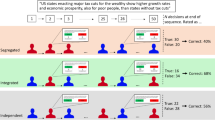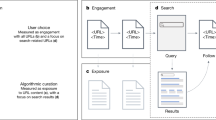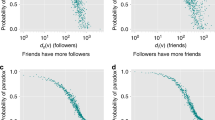Abstract
Identity cues appear ubiquitously alongside content in social media today. Some also suggest universal identification, with names and other cues, as a useful deterrent to harmful behaviours online. Unfortunately, we know little about the effects of identity cues on opinions and online behaviours. Here we used a large-scale longitudinal field experiment to estimate the extent to which identity cues affect how people form opinions about and interact with content online. We randomly assigned content produced on a social news aggregation website to ‘identified’ and ‘anonymous’ conditions to estimate the causal effect of identity cues on how viewers vote and reply to content. The effects of identity cues were significant and heterogeneous, accounting for between 28% and 61% of the variation in voting associated with commenters’ production, reputation and reciprocity. Our results also showed that identity cues cause people to vote on content faster (consistent with heuristic processing) and to vote according to content producers’ reputations, production history and reciprocal votes with content viewers. These results provide evidence that rich-get-richer dynamics and inequality in social content evaluation are mediated by identity cues. They also provide insights into the evolution of status in online communities. From a practical perspective, we show via simulation that social platforms may improve content quality by including votes on anonymized content as a ranking signal.
This is a preview of subscription content, access via your institution
Access options
Access Nature and 54 other Nature Portfolio journals
Get Nature+, our best-value online-access subscription
$29.99 / 30 days
cancel any time
Subscribe to this journal
Receive 12 digital issues and online access to articles
$119.00 per year
only $9.92 per issue
Buy this article
- Purchase on Springer Link
- Instant access to full article PDF
Prices may be subject to local taxes which are calculated during checkout






Similar content being viewed by others
Data availability
An anonymized version of the data supporting this study is retained indefinitely for reproducibility. The data can be accessed from the authors by signing a non-disclosure agreement available at the following GitHub repository: https://github.com/seanjtaylor/identify_effects_in_social_media. The NDA requires that researchers provide their affiliation and attest that they will only use the data for reproduction and that no attempt will be made to re-engineer the identities of users or the platform.
Code availability
The code supporting this study is available at the following GitHub repository: https://github.com/seanjtaylor/identify_effects_in_social_media.
References
Burns, W. Is it time to require identity verification for everyone using social media? Forbes https://www.forbes.com/sites/willburns/2018/02/22/is-it-time-to-require-identity-verification-for-everyone-using-social-media/?sh=74308aec8683 (2018).
Salganik, M. J. & Watts, D. J. Leading the herd astray: an experimental study of self-fulfilling prophecies in an artificial cultural market. Soc. Psychol. Q. 71, 338–355 (2008).
Lorenz, J., Rauhut, H., Schweitzer, F. & Helbing, D. How social influence can undermine the wisdom of crowd effect. Proc. Natl Acad. Sci. USA 108, 9020–9025 (2011).
Muchnik, L., Aral, S. & Taylor, S. J. Social influence bias: a randomized experiment. Science 341, 647–651 (2013).
Chaiken, S. Heuristic versus systematic information processing and the use of source versus message cues in persuasion. J. Pers. Soc. Psychol. 39, 752–766 (1980).
Chaiken, S. in Social Influence: The Ontario Symposium Vol. 5 (eds Zanna, M. P. et al.) 3–39 (Lawrence Erlbaum Associates, 1987).
Hass, R. G. in Cognitive Responses in Persuasion Vol. 2 (eds Petty, R. E. et al.) Ch. 7 (Lawrence Erlbaum Associates, 1981); https://doi.org/10.4324/9781315803012
Walther, J. B. Relational aspects of computer-mediated communication: experimental observations over time. Organ. Sci. 6, 186–203 (1995).
Walther, J. B. Computer-mediated communication: impersonal, interpersonal, and hyperpersonal interaction. Commun. Res. 23, 3–43 (1996).
Resnick, P., Kuwabara, K., Zeckhauser, R. & Friedman, E. Reputation systems. Commun. ACM 43, 45–48 (2000).
Pavlou, P. A. & Gefen, D. Building effective online marketplaces with institution-based trust. Inf. Syst. Res. 15, 37–59 (2004).
Moon, J. Y. & Sproull, L. S. The role of feedback in managing the Internet-based volunteer work force. Inf. Syst. Res. 19, 494–515 (2008).
Wetzer, I. M., Zeelenberg, M. & Pieters, R. “Never eat in that restaurant, I did!”: exploring why people engage in negative word-of-mouth communication. Psychol. Mark. 24, 661–680 (2007).
Wood, W. Attitude change: persuasion and social influence. Annu. Rev. Psychol. 51, 539–570 (2000).
Cialdini, R. B. & Trost, M. R. Social Influence: Social Norms, Conformity and Compliance. The handbook of social psychology, McGraw-Hill, 151–192 (1998).
Chaiken, S., Wood, W. & Eagly, A. H. Principles of Persuasion. Social psychology: Handbook of basic principles. Guilford, 702–742 (1996).
Chen, S., Shechter, D. & Chaiken, S. Getting at the truth or getting along: accuracy- versus impression-motivated heuristic and systematic processing. J. Pers. Soc. Psychol. 71, 262–275 (1996).
Lundgren, S. R. & Prislin, R. Motivated cognitive processing and attitude change. Pers. Soc. Psychol. Bull. 24, 715–726 (1998).
Petty, R. E. & Wegener, D. T. Matching versus mismatching attitude functions: implications for scrutiny of persuasive messages. Pers. Soc. Psychol. Bull. 24, 227–240 (1998).
Tajfel, H. Social psychology of intergroup relations. Annu. Rev. Psychol. 33, 1–39 (1982).
Turner, J. C. Social Influence (Thomson Brooks/Cole, 1991).
Flache, A. Models of social influence: towards the next frontiers. J. Artif. Soc. Soc. Simul. https://doi.org/10.18564/jasss.3521 (2017).
Aral, S. & Walker, D. Creating social contagion through viral product design: a randomized trial of peer influence in networks. Manag. Sci. 57, 1623–1639 (2011).
Aral, S. & Walker, D. Identifying influential and susceptible members of social networks. Science 337, 337–341 (2012).
Bakshy, E., Eckles, D., Yan, R. & Rosenn, I. Social influence in social advertising: evidence from field experiments. In Proc. 13th ACM Conference on Electronic Commerce 146–161 (ACM, 2012); https://doi.org/10.1145/2229012.2229027
Aral, S. & Walker, D. Tie strength, embeddedness, and social influence: a large-scale networked experiment. Manag. Sci. 60, 1352–1370 (2014).
Tucker, C. Social Advertising: How Advertising that Explicitly Promotes Social Influence Can Backfire. SSRN https://doi.org/10.2139/ssrn.1975897 (2016).
Bakshy, E., Rosenn, I., Marlow, C. & Adamic, L. The role of social networks in information diffusion. In Proc. 21st International Conference on World Wide Web 519–528 (ACM, 2012).
Bapna, R. & Umyarov, A. Do your online friends make you pay? A randomized field experiment on peer influence in online social networks. Manag. Sci. 61, 1902–1920 (2015).
Luc, J. G. Y. et al. Does tweeting improve citations? One-year results from the TSSMN prospective randomized trial. Ann. Thorac. Surg. 111, 296–300 (2021).
Forman, C., Ghose, A. & Wiesenfeld, B. Examining the relationship between reviews and sales: the role of reviewer identity disclosure in electronic markets. Inf. Syst. Res. 19, 291–313 (2008).
Ma, M. & Agarwal, R. Through a glass darkly: information technology design, identity verification, and knowledge contribution in online communities. Inf. Syst. Res. 18, 42–67 (2007).
Shalizi, C. R. & Thomas, A. C. Homophily and contagion are generically confounded in observational social network studies. Sociol. Methods Res. 40, 211–239 (2011).
Toubia, O. & Stephen, A. T. Intrinsic vs. image-related utility in social media: why do people contribute content to twitter? Mark. Sci. 32, 368–392 (2013).
Taylor, S. J., Bakshy, E. & Aral, S. Selection effects in online sharing: consequences for peer adoption. In ACM Conference on Electronic Commerce 821–836 (ACM, 2013); https://doi.org/10.1145/2492002.2482604
Bertrand, M. & Mullainathan, S. Are Emily and Greg more employable than Lakisha and Jamal? A field experiment on labor market discrimination. Am. Econ. Rev. 94, 991–1013 (2004).
Edelman, B., Luca, M. & Svirsky, D. Racial discrimination in the sharing economy: evidence from a field experiment. Am. Econ. J. Appl. Econ. 9, 1–22 (2017).
Hu, N., Zhang, J. & Pavlou, P. A. Overcoming the J-shaped distribution of product reviews. Commun. ACM 52, 144–147 (2009).
Kahneman, D., Sibony, O. & Sunstein, C. R. Noise: A Flaw in Human Judgment (Little, Brown, 2021).
Bourdieu, P. in: Handbook for Theory and Research for the Sociology of Education (ed. Richardson, J.). Greenwood Press, 241–258 (1986).
Throsby, D. Cultural capital. J. Cult. Econ. 23, 3–12 (1999).
Putnam, R. The prosperous community: social capital and public life. The American Prospect https://prospect.org/infrastructure/prosperous-community-social-capital-public-life (1993).
Lin, C.-S. & Chen, Y.-F. Examining social tagging behaviour and the construction of an online folksonomy from the perspectives of cultural capital and social capital. J. Inf. Sci. 38, 540–557 (2012).
Simon, H.A. On a class of skew distribution functions. Biometrika 42, 425–440 (1955).
Merton, R. K. The Matthew effect in science. Science 159, 56–63 (1968).
Barabási, A.-L. & Albert, R. Emergence of scaling in random networks. Science 286, 509–512 (1999).
Salganik, M. J., Dodds, P. S. & Watts, D. J. Experimental study of inequality and unpredictability in an artificial cultural market. Science 311, 854–856 (2006).
Van de Rijt, A. Self-correcting dynamics in social influence processes. Am. J. Sociol. 124, 1468–1495 (2019).
Berry, G. & Taylor, S. J. Discussion quality diffuses in the digital public square. In Proc. 26th International Conference on World Wide Web 1371–1380 (ACM, 2017); https://doi.org/10.1145/3038912.3052666
Taylor, S. J. & Eckles, D. in Complex Spreading Phenomena in Social Systems (eds Lehmann, S. & Ahn, Y. Y.) 289–322 (Springer, 2018); https://doi.org/10.1007/978-3-319-77332-2_16
Sun, T. & Taylor, S. J. Displaying things in common to encourage friendship formation: a large randomized field experiment. Quant. Mark. Econ. 18, 237–271 (2020).
Acknowledgements
We thank members of the MIT Initiative on the Digital Economy for valuable feedback. L.M. acknowledges support from the Israel Science Foundation (Grant 2566/21) and the David Goldman Data-Driven Innovation Research Centre for supporting this research. The authors received no specific funding for this work.
Author information
Authors and Affiliations
Contributions
S.J.T., L.M. and S.A. performed the research design and data analysis. S.J.T., M.K. and S.A. did the writing.
Corresponding author
Ethics declarations
Competing interests
The authors declare no competing interests.
Peer review
Peer review information
Nature Human Behaviour thanks Johan Ugander, Marijn Keijzer and the other, anonymous, reviewer(s) for their contribution to the peer review of this work.
Additional information
Publisher’s note Springer Nature remains neutral with regard to jurisdictional claims in published maps and institutional affiliations.
Supplementary information
Supplementary Information
Supplementary Sections A.1–A.7, Figs. B3–B7 and Tables C3–C5.
Rights and permissions
Springer Nature or its licensor (e.g. a society or other partner) holds exclusive rights to this article under a publishing agreement with the author(s) or other rightsholder(s); author self-archiving of the accepted manuscript version of this article is solely governed by the terms of such publishing agreement and applicable law.
About this article
Cite this article
Taylor, S.J., Muchnik, L., Kumar, M. et al. Identity effects in social media. Nat Hum Behav 7, 27–37 (2023). https://doi.org/10.1038/s41562-022-01459-8
Received:
Accepted:
Published:
Issue Date:
DOI: https://doi.org/10.1038/s41562-022-01459-8
This article is cited by
-
Domain-adaptive pre-training on a BERT model for the automatic detection of misogynistic tweets in Spanish
Social Network Analysis and Mining (2023)



